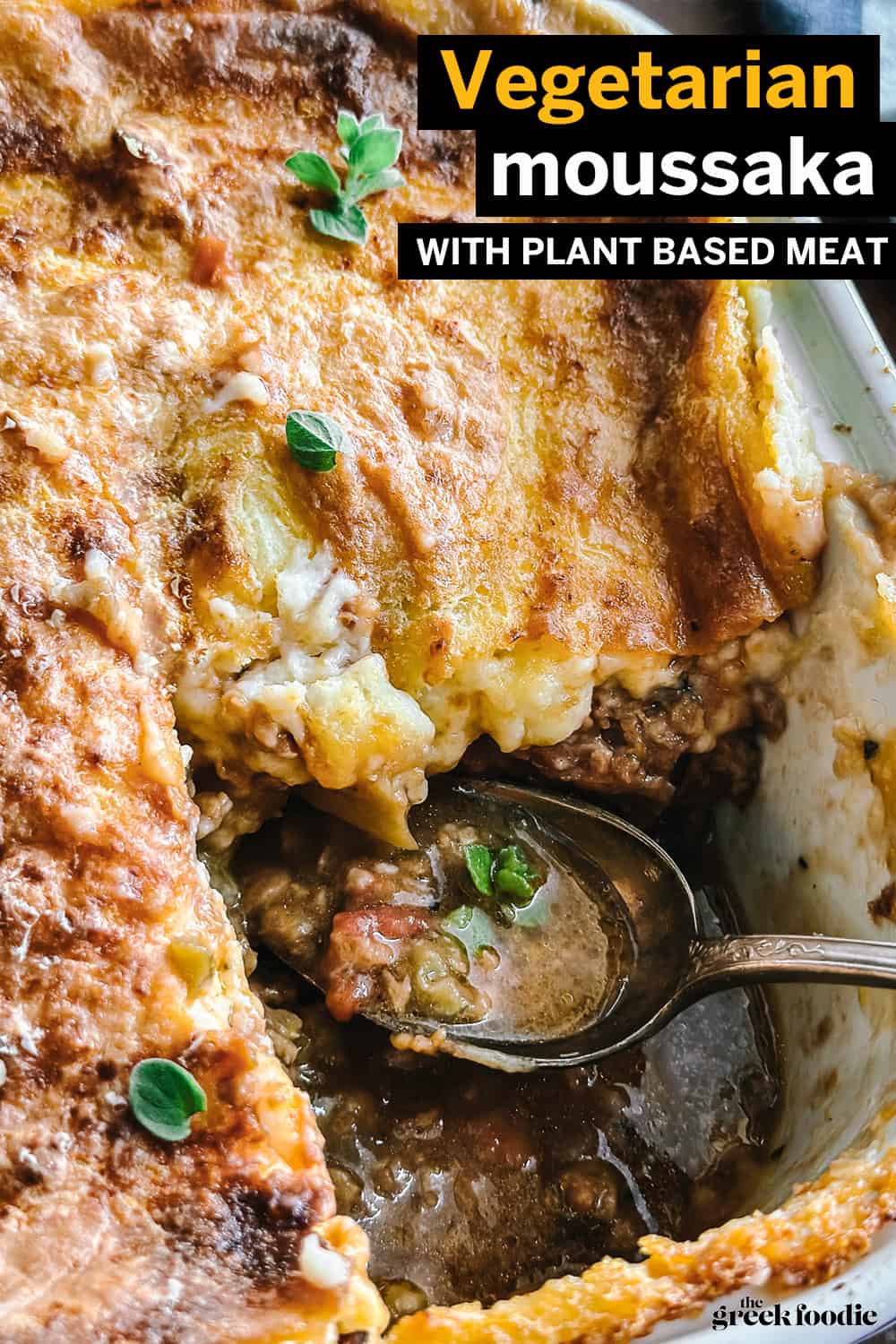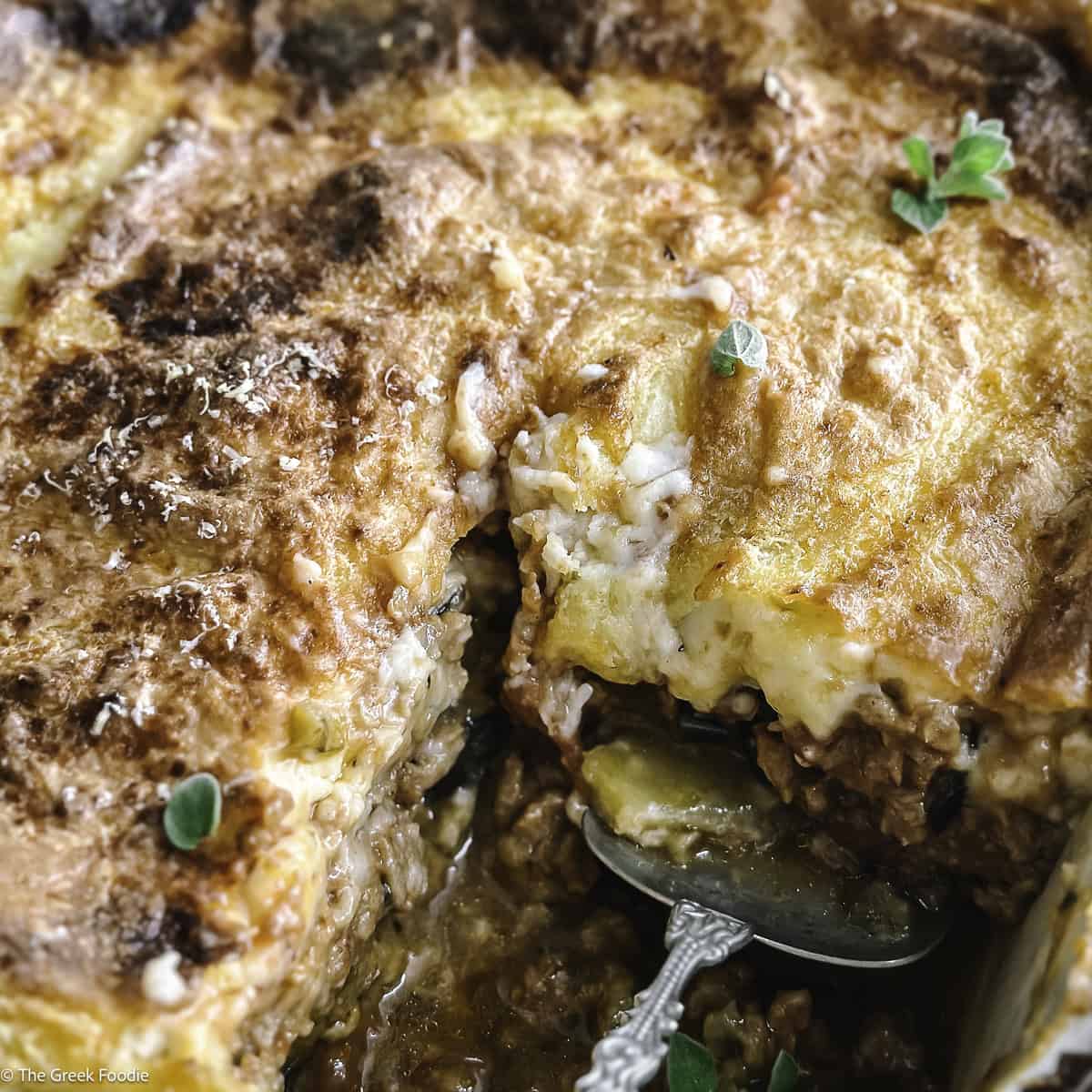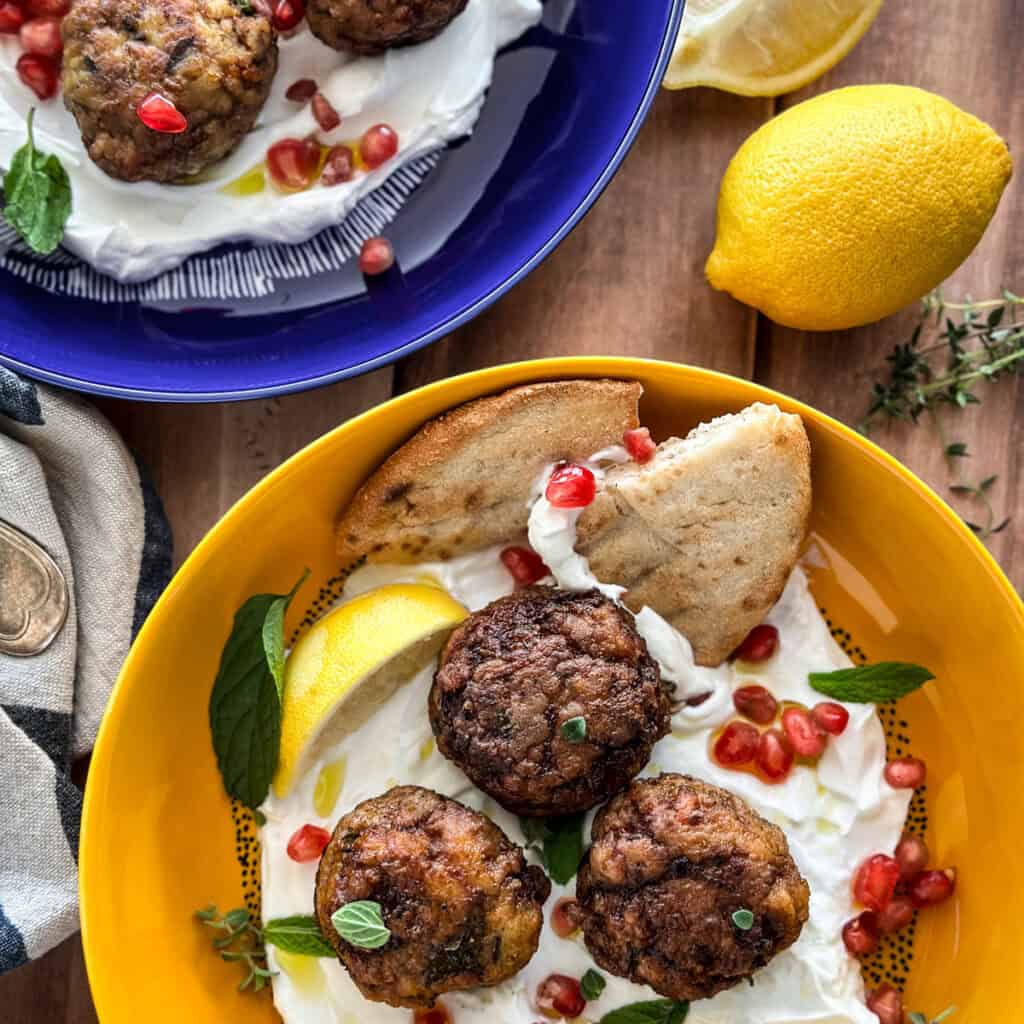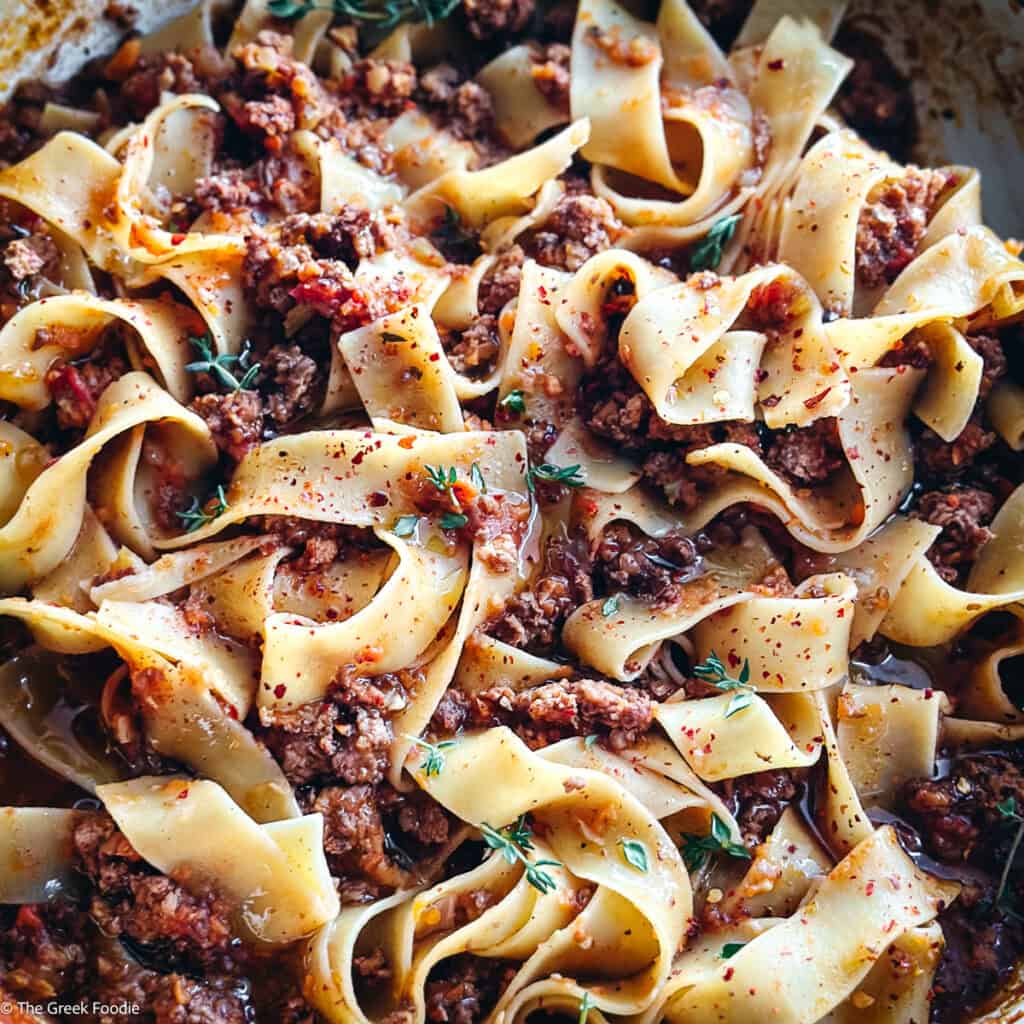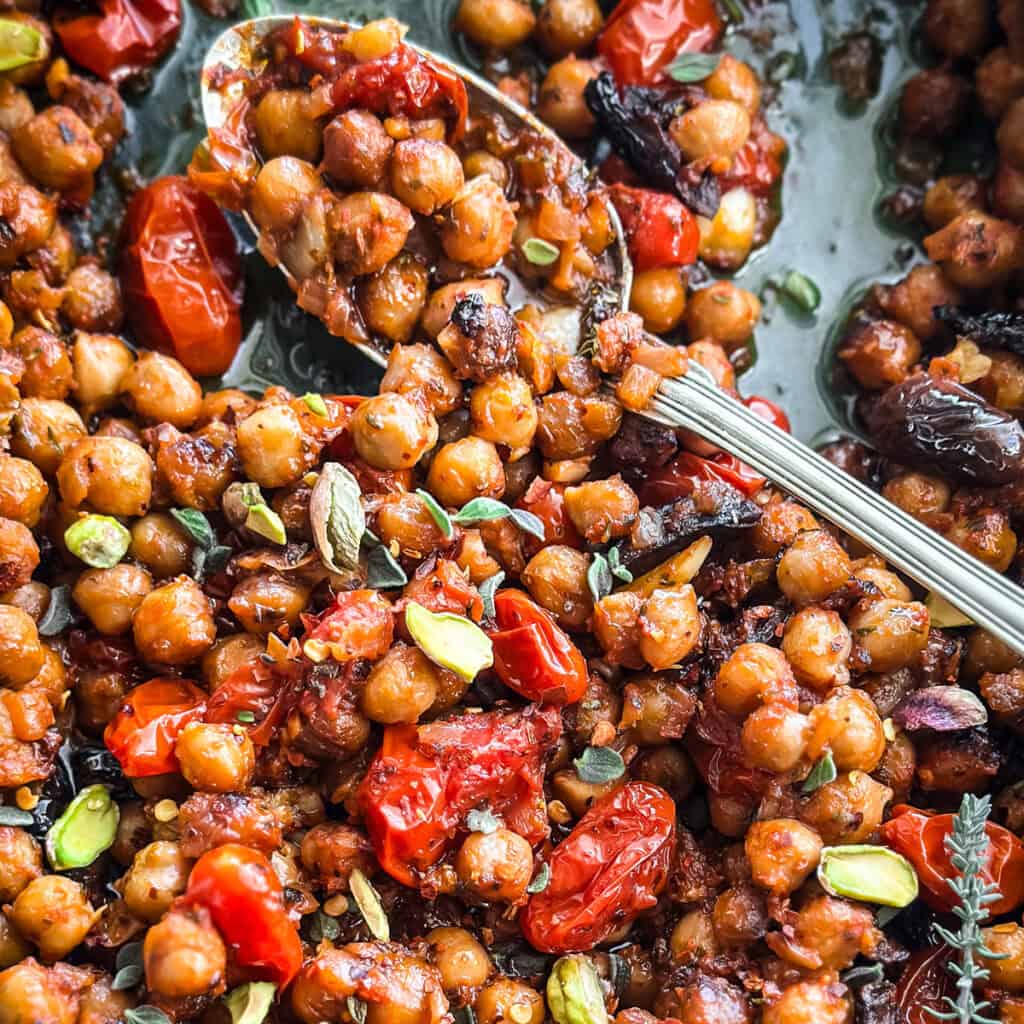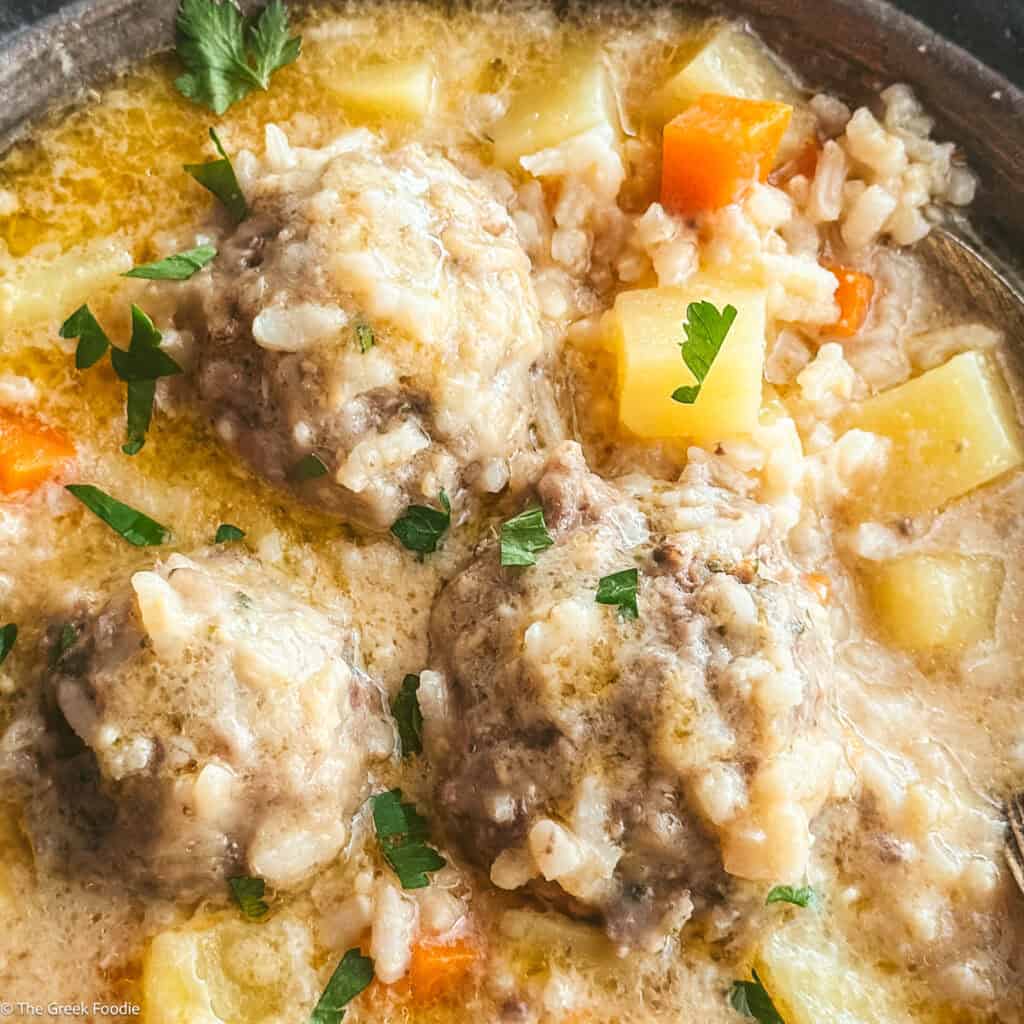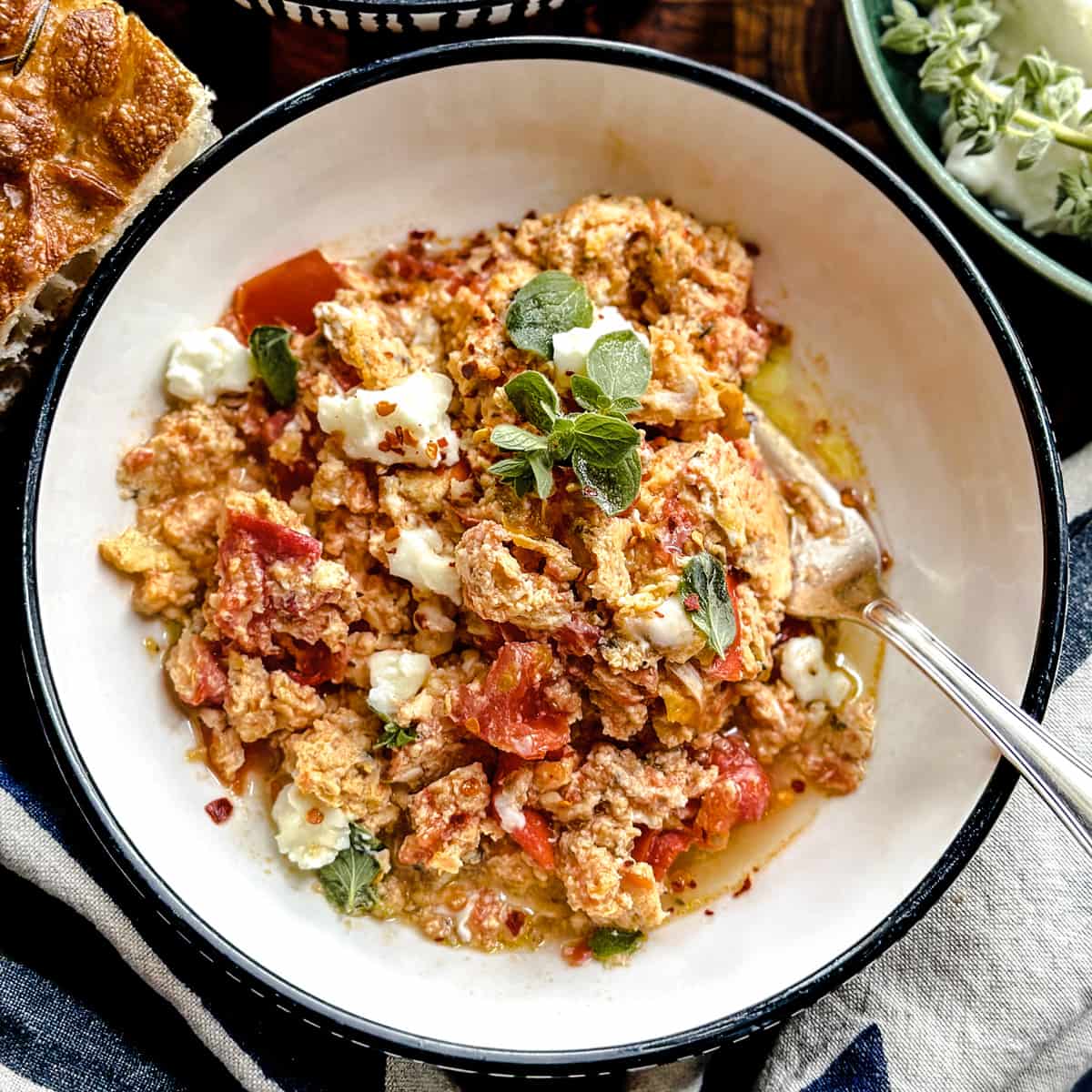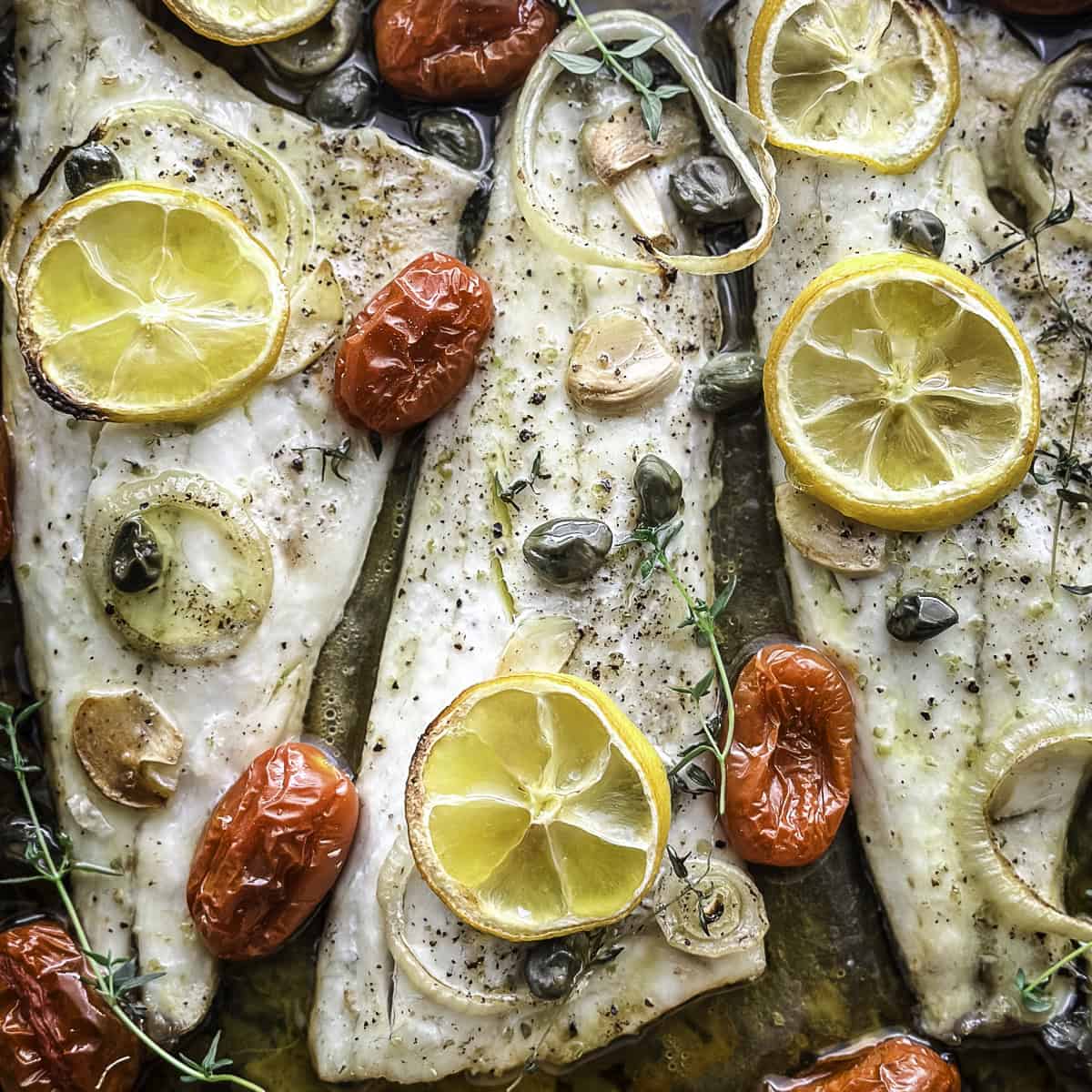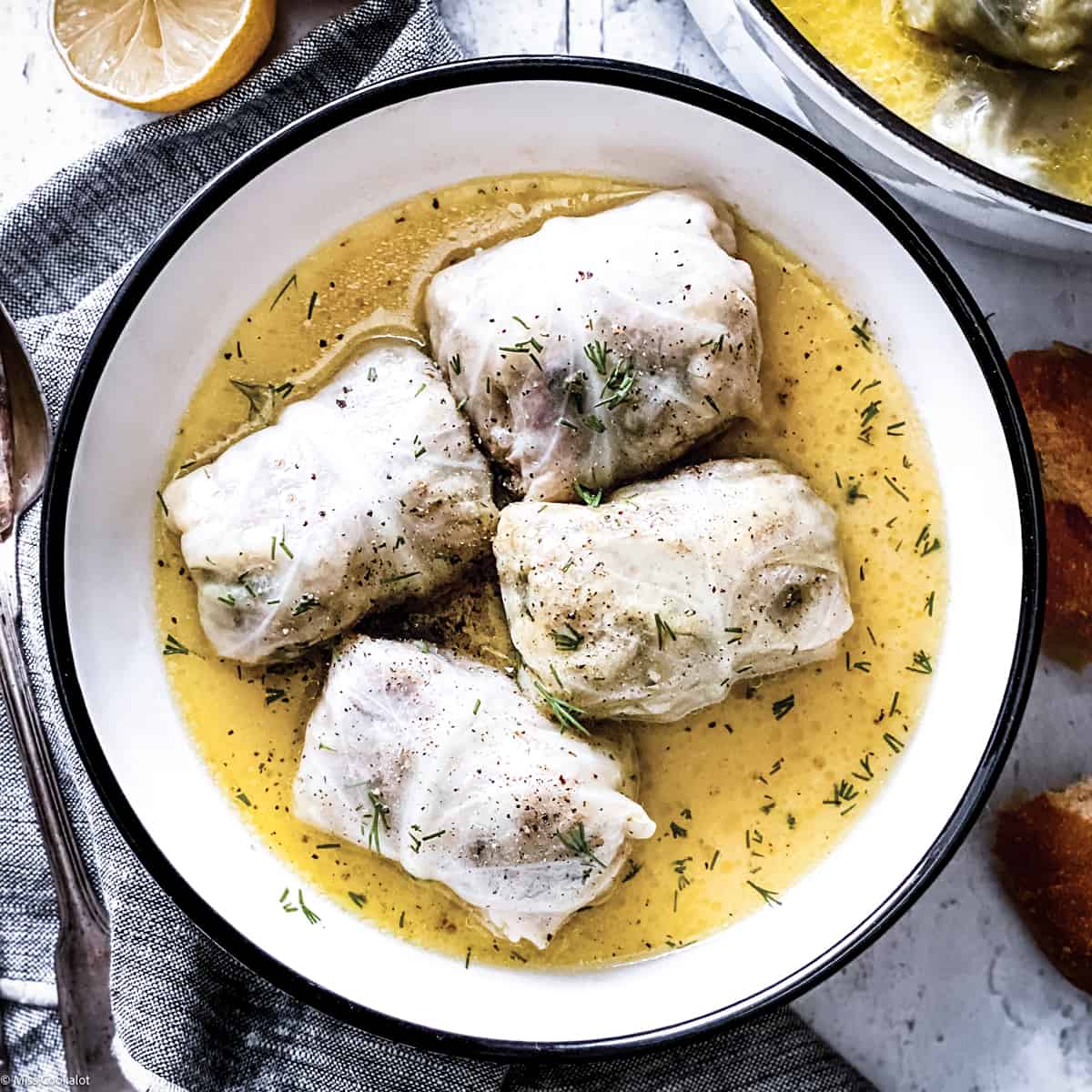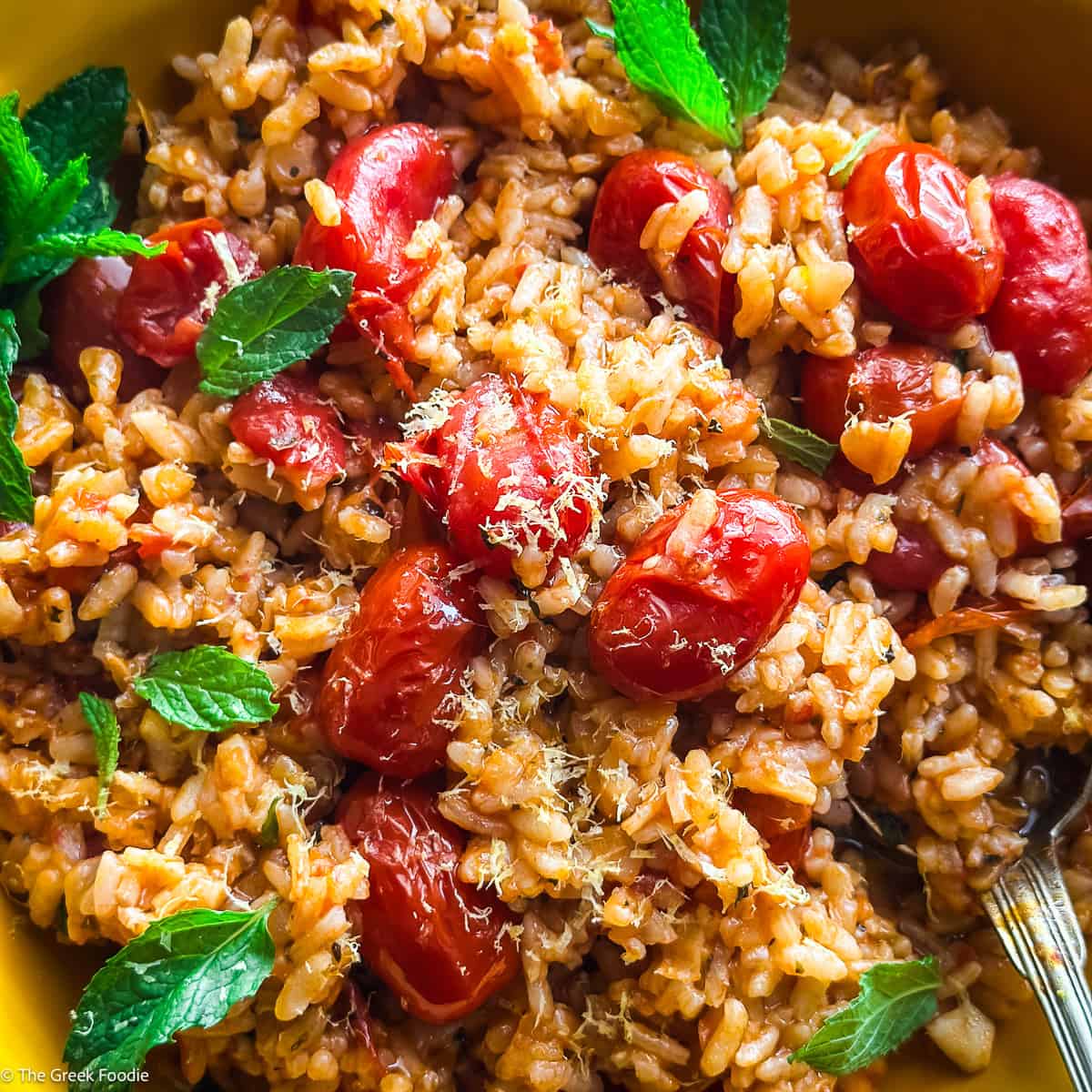This Vegetarian Moussaka captures all the comforting, layered flavors of the classic Greek favorite without the meat. Tender roasted eggplant, golden potatoes, and flavorful plant-based Beyond Beef come together under a velvety béchamel sauce that’s baked to perfection. The result is a hearty, satisfying casserole that feels every bit as indulgent as the traditional version, yet lighter and completely vegetarian.
Whether you’re following a plant-based diet or just looking to enjoy a wholesome twist on a Greek classic, this moussaka delivers all the flavor and comfort you crave, a true taste of the Mediterranean in one beautiful dish.
What cooks say:
“I have made this recipe a couple of times and it’s always a winner! Delicious and comforting while light!
Great for all year round and also freezes well before you bake it. I always make a double dose, one to bake and one to freeze for a lazy day or that impromptu potluck!”
Eri manley
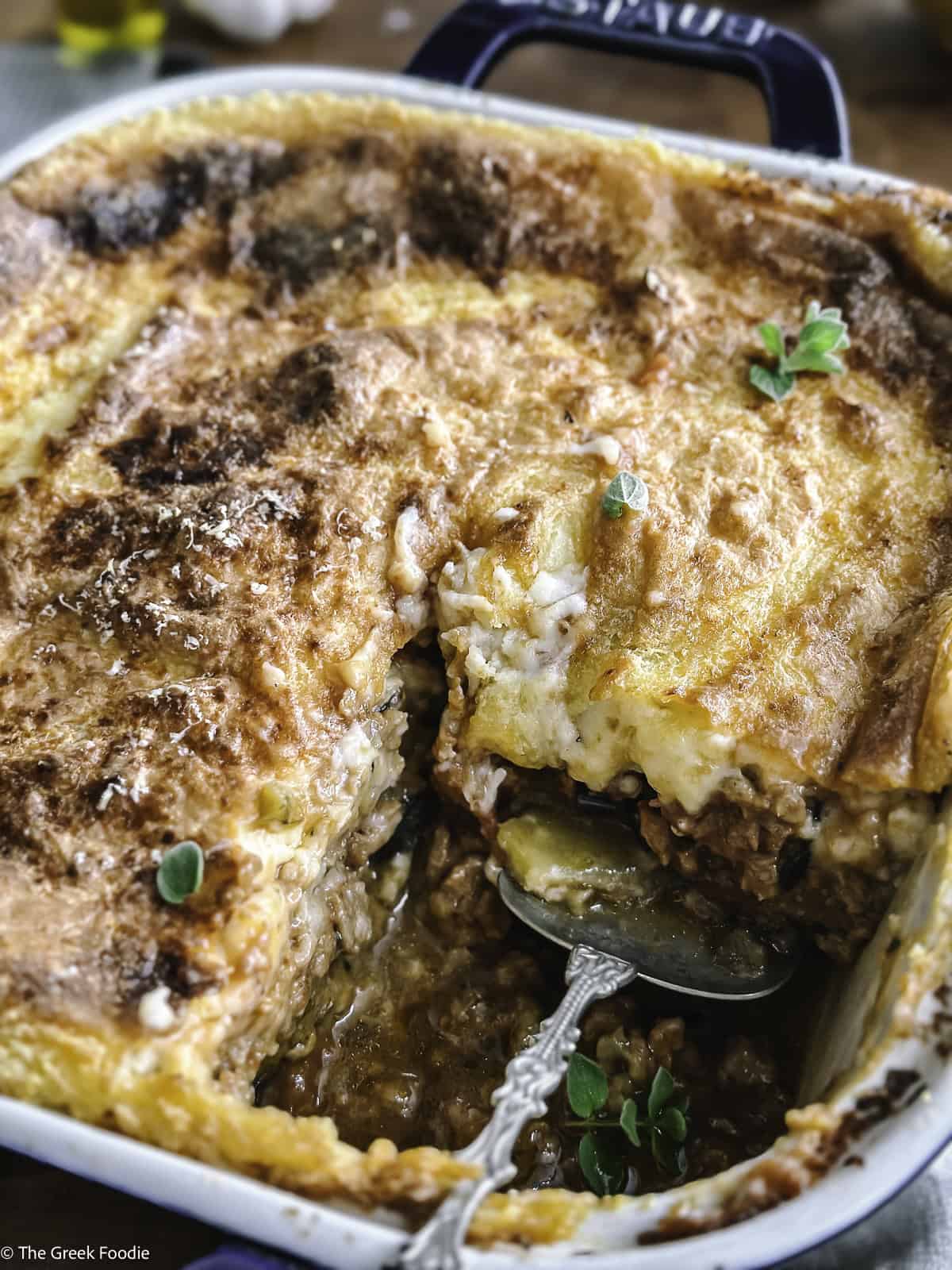
Why you will love vegetarian moussaka
Here is what you need
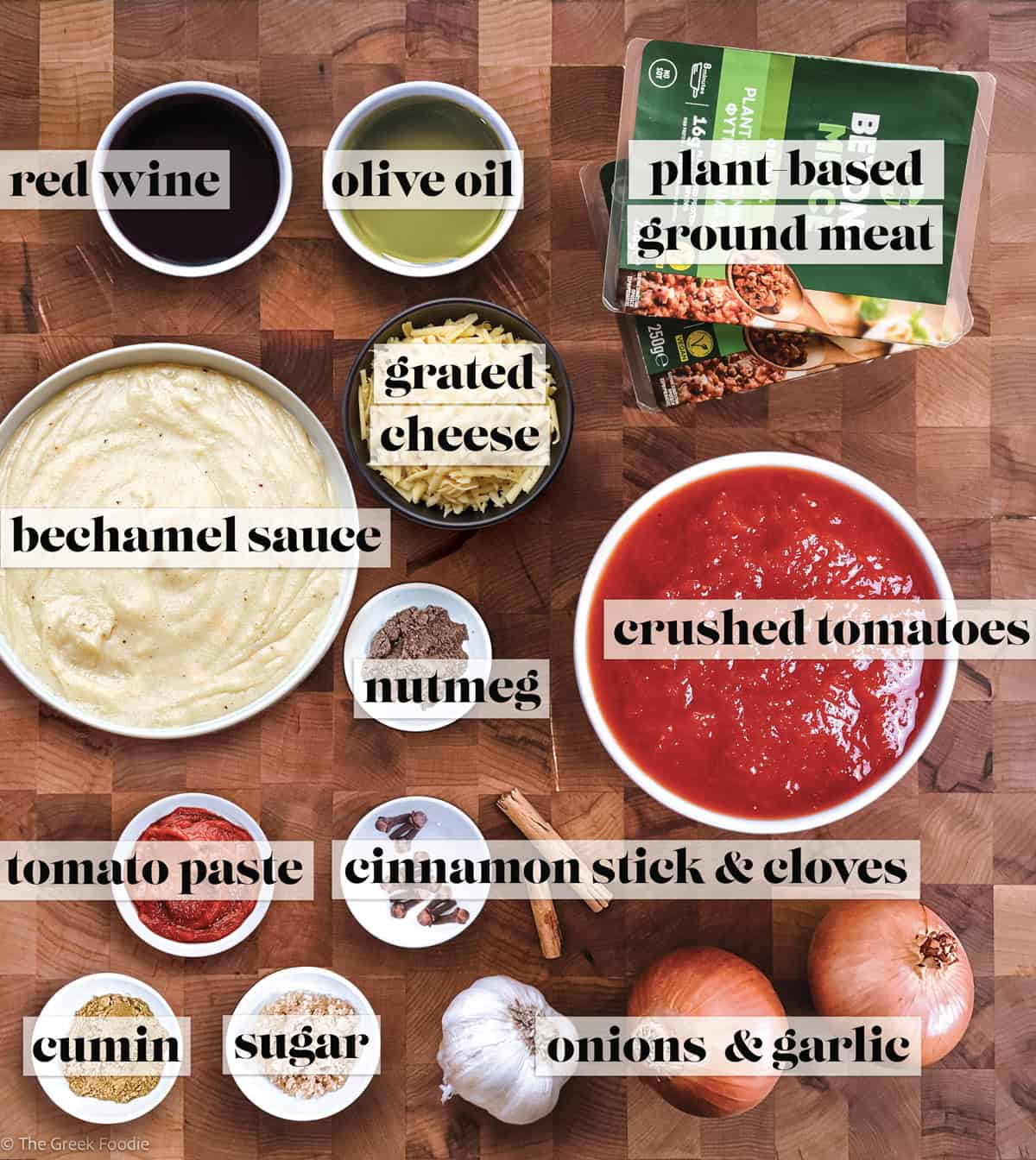
- Plant-based meat – A high-quality plant-based ground, like Beyond Beef, works beautifully in place of traditional beef or lamb. It absorbs the classic moussaka spices and tomato sauce, creating a hearty, flavorful filling that tastes incredibly close to the original.
- Béchamel sauce – You can make the classic béchamel following our traditional moussaka recipe, or go fully plant-based with the vegan version included in the recipe card. Both are silky, rich, and create that irresistible golden crust when baked.
- Grated cheese – Parmigiano Reggiano adds a subtle salty bite, but feel free to use your favorite vegan cheese for a dairy-free option. Look for one that melts easily and has a mild, nutty flavor.
- Onions and garlic – These essential aromatics build depth in the sauce. Sauté them slowly until soft and fragrant for the best flavor base.
- Tomato paste – A small spoonful of tomato paste adds richness and concentration to the sauce; don’t skip it.
- Tomatoes – Use good-quality canned tomatoes for the best result. Authentic Italian San Marzano tomatoes are ideal; simply pulse them in a food processor for a smoother sauce.
- Dry red wine – A splash of dry red wine brings depth and balance to the tomato sauce. White wine also works well. If you prefer to cook without alcohol, you can skip it; the sauce will still be delicious.
- Spices and herbs – Cinnamon stick, cloves, ground cumin, nutmeg, dried oregano, and a bay leaf — these are the heart of Greek moussaka flavor. They give warmth, complexity, and a touch of Mediterranean magic.
- Extra virgin olive oil – Use a good-quality olive oil for sautéing and drizzling over the vegetables. It ties all the flavors together and enhances the dish’s authentic Greek character.
You also need
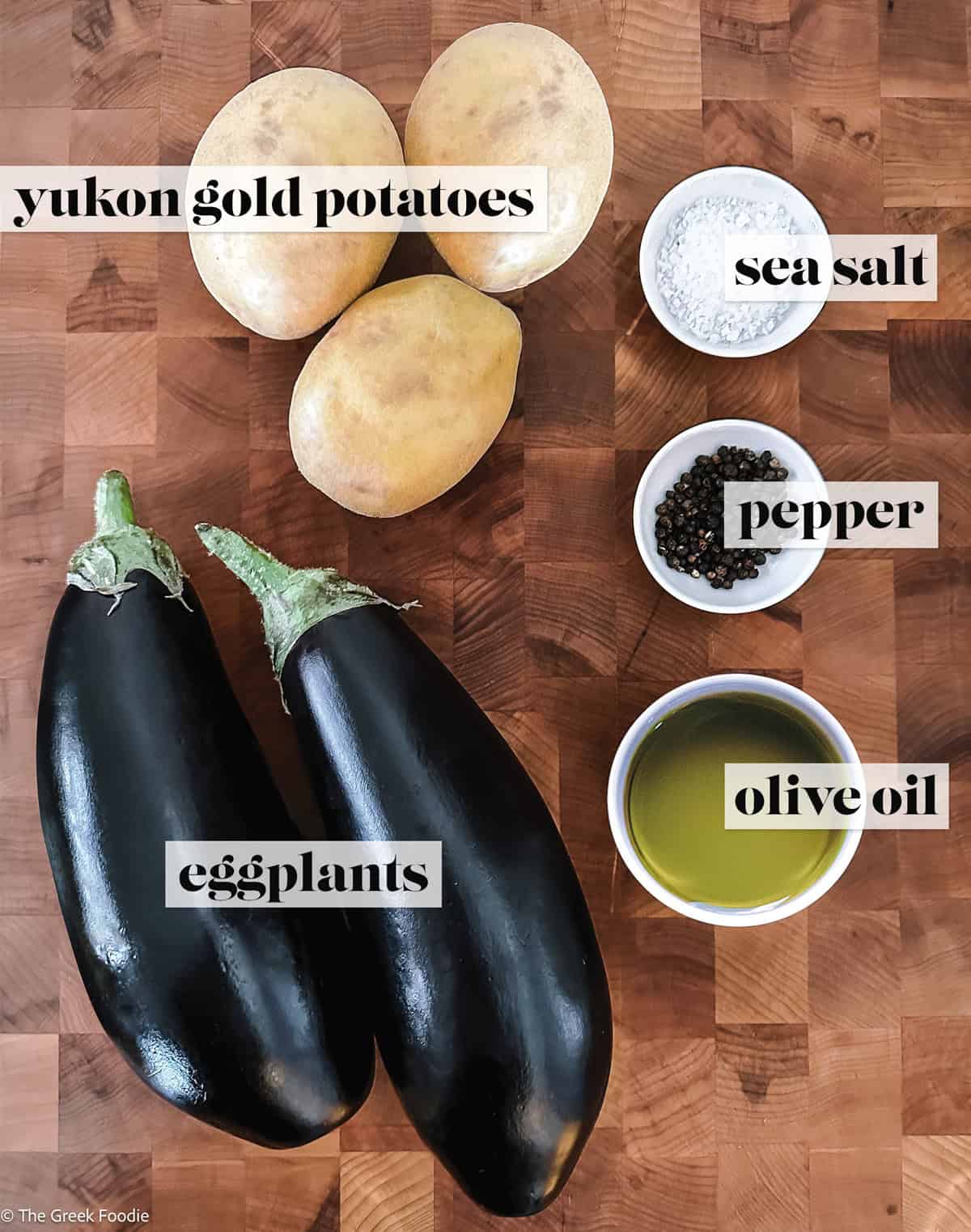
- Potatoes – I love using Yukon Gold potatoes for moussaka. They have a creamy texture, mild flavor, and thin, edible skin, so there’s no need to peel them. Just scrub them well before slicing and roasting. Their golden color adds a lovely contrast to the layers.
- Eggplants – In Greece, we have many varieties of eggplant, but my favorite for moussaka is flaskes — large, deep-purple eggplants with fluffy flesh and slightly firm skin. They’re very similar to the American or Globe eggplants commonly found in the U.S. Depending on the season, they can have a mild bitterness and some seeds, but their size and texture make them perfect for layered dishes like moussaka and papoutsakia.
- Oil for frying– I use extra virgin olive oil for everything, even frying. It’s a myth that olive oil can’t handle heat; in Greek kitchens, it’s the go-to for flavor and authenticity. That said, you can use sunflower or another neutral vegetable oil if you prefer or want a more economical option.
- Sea salt & freshly ground pepper – These simple seasonings bring balance and highlight the natural flavors of every layer. Use good-quality sea salt and freshly ground pepper for the best results.

Suggestions & Substitutions
- Roast the vegetables first. Roasting the eggplant and potatoes before assembling the moussaka gives them a richer flavor and keeps the casserole from becoming watery. Brush them lightly with olive oil and roast until golden.
- Use any plant-based ground you like. Beyond Beef works wonderfully, but you can also use other brands or make your own filling with crumbled tofu, lentils, or finely chopped mushrooms and walnuts for a more rustic, homemade feel.
- Adjust the béchamel to your preference. If you’re making it vegan, swap the butter and milk with olive oil and plant milk (like oat or almond). A touch of nutritional yeast adds cheesy flavor without dairy.
- Layer with care. Arrange the roasted potatoes at the bottom, add the plant-based meat sauce, then the eggplant slices, and finish with the béchamel. This keeps the structure neat and gives every bite a perfect balance of textures.
- Make ahead & freeze. You can assemble the moussaka a day ahead, refrigerate it covered, and bake it before serving. It also freezes beautifully — just let it cool completely, wrap tightly, and freeze for up to 2 months.
- Add a hint of Greek sunshine. Fresh oregano or thyme leaves sprinkled between layers bring a bright Mediterranean note that complements the rich sauce perfectly.
Moussakas needs a plan
Moussaka is a labor of love, and having a plan makes all the difference. Staying organized will help everything come together smoothly — and keep your kitchen calm in the process!
Here’s the outline I like to follow:
- Start the sauce.
Begin with the plant-based meat sauce so the flavors can develop while you work on the rest. - Prepare the vegetables.
Roast or fry the eggplant and potatoes until tender and golden. - Preheat the oven.
Make sure it’s ready before you start layering. - Make the béchamel.
Whisk up the creamy topping — classic or vegan — just before assembling. - Assemble the moussaka.
Layer potatoes, sauce, eggplant, and béchamel in your baking dish. - Bake until golden.
The top should be lightly browned and set. Let it rest before slicing — it will hold its shape beautifully.
Step by step
Step 1: Make the Plant-Based Meat Sauce
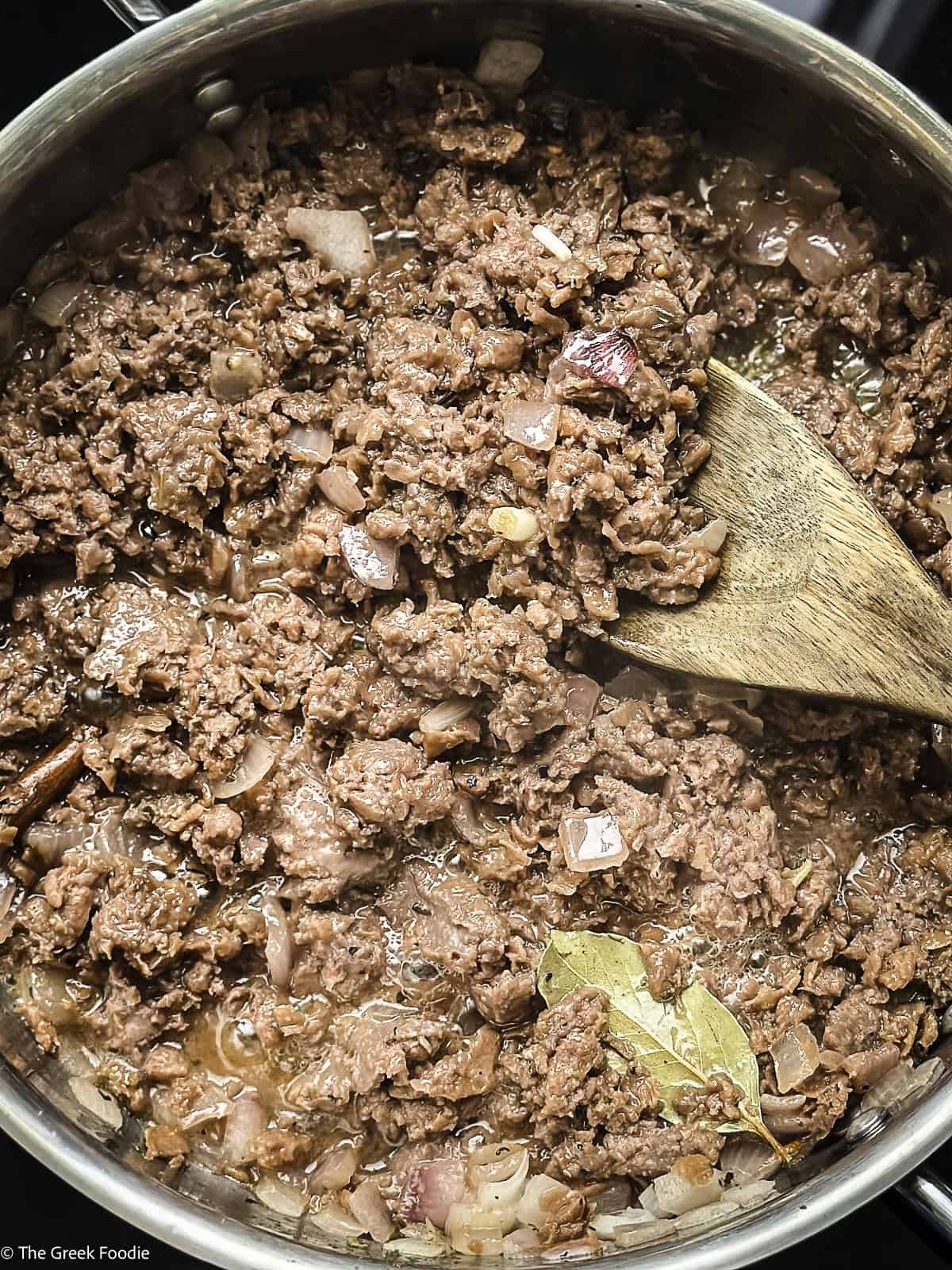
- Stir in the tomatoes and 1 teaspoon of sugar. Simmer over low heat for about 20 minutes, until the sauce thickens and becomes rich and flavorful.
- Heat 2 tablespoons of olive oil in a deep saucepan. Add the plant-based ground and cook over high heat, breaking it apart with a wooden spoon until browned.
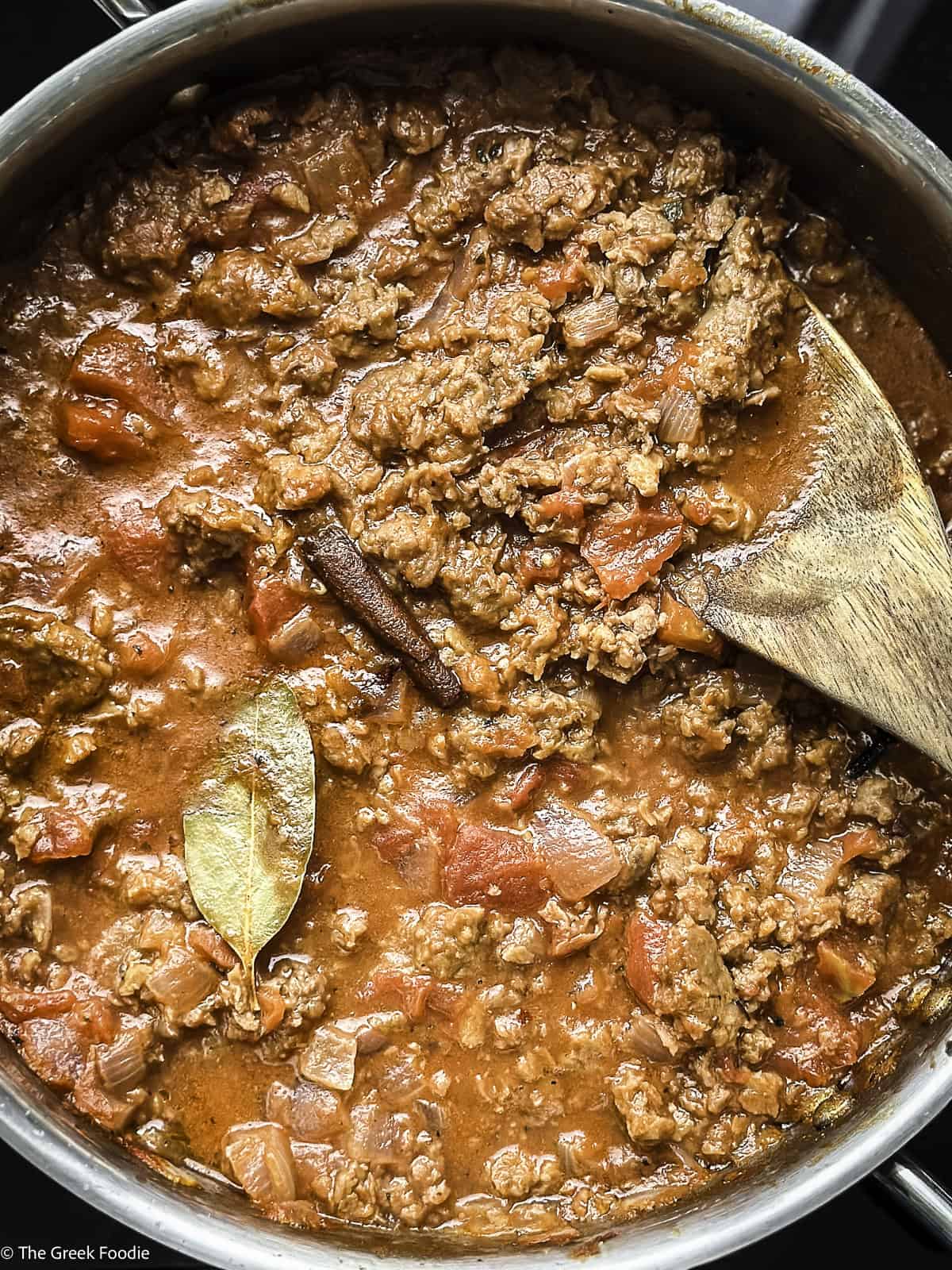
- Stir in the onion, garlic, sea salt, pepper, cinnamon stick, nutmeg, cumin, bay leaf, and cloves. Sauté until the onion softens and becomes fragrant.
- Add the tomato paste and cook for 2–3 minutes, stirring to combine. Pour in the wine and let the alcohol evaporate.
Step 2: Prepare the Vegetables
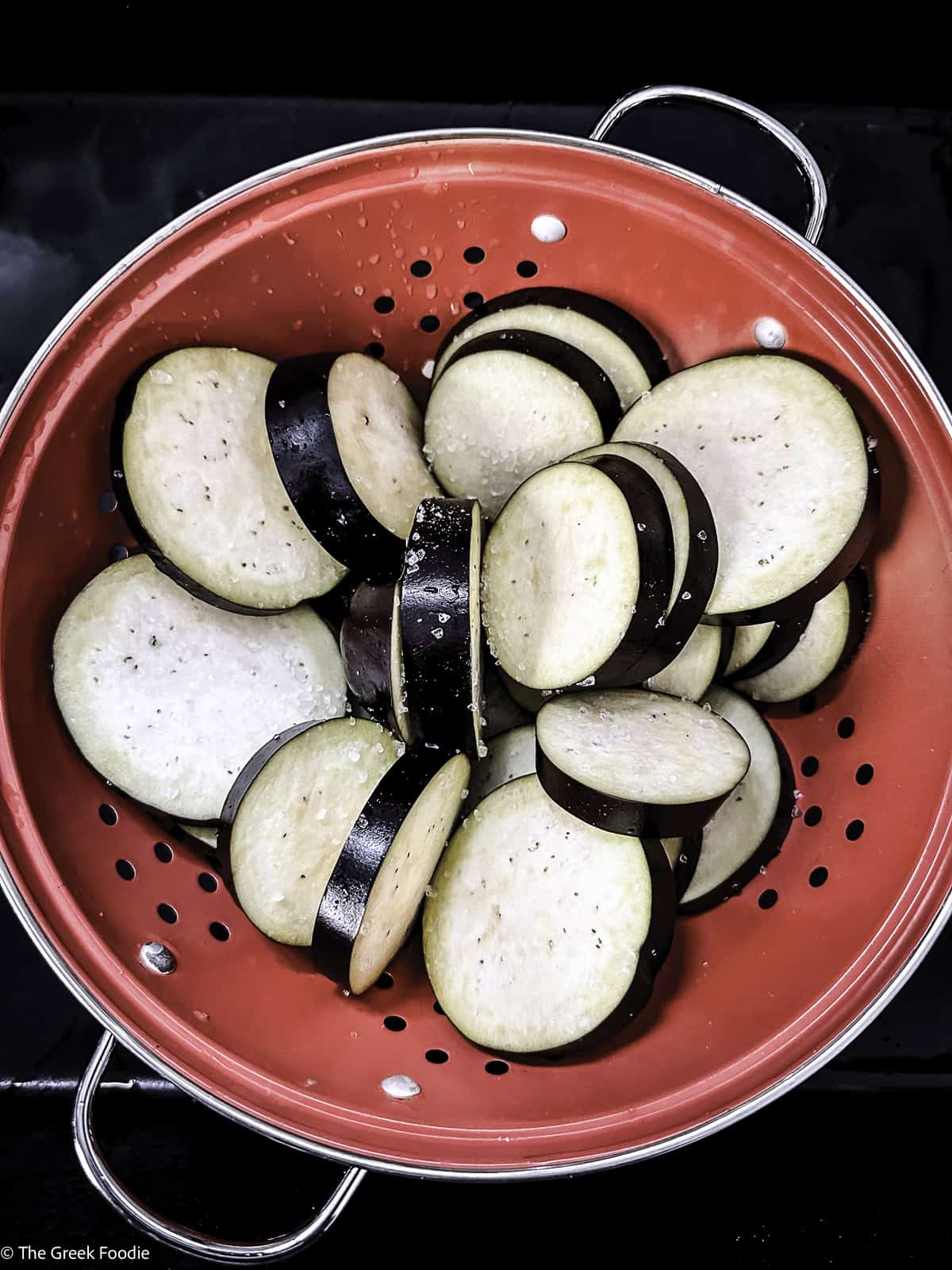
- Slice the eggplants about 1 cm (⅓ inch) thick. Sprinkle with sea salt and place in a colander to drain their liquids for about 15 minutes.
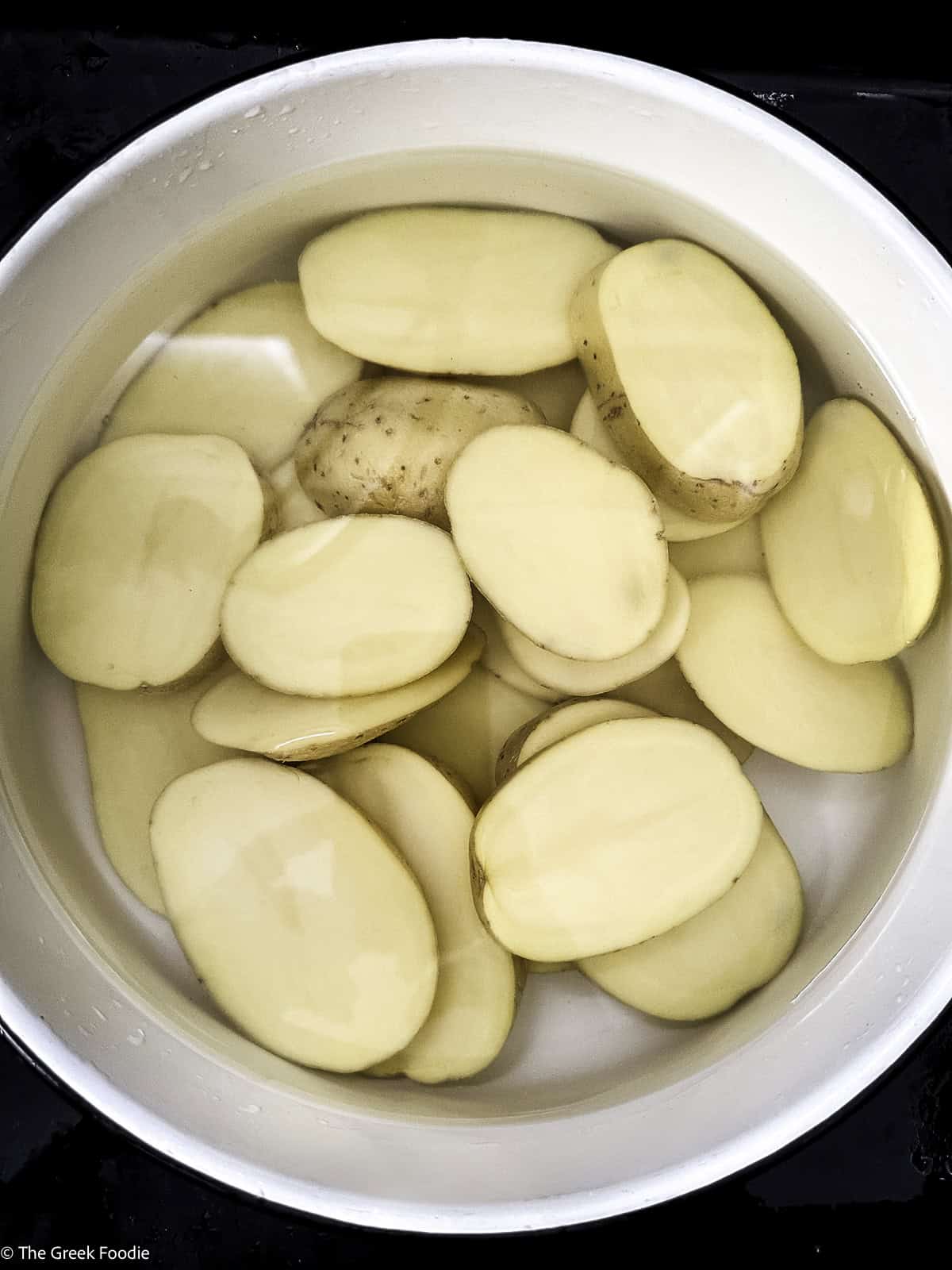
- Slice the potatoes about 6 mm (¼ inch) thick. Place the slices in a bowl of water to prevent browning, then drain and pat dry before frying.
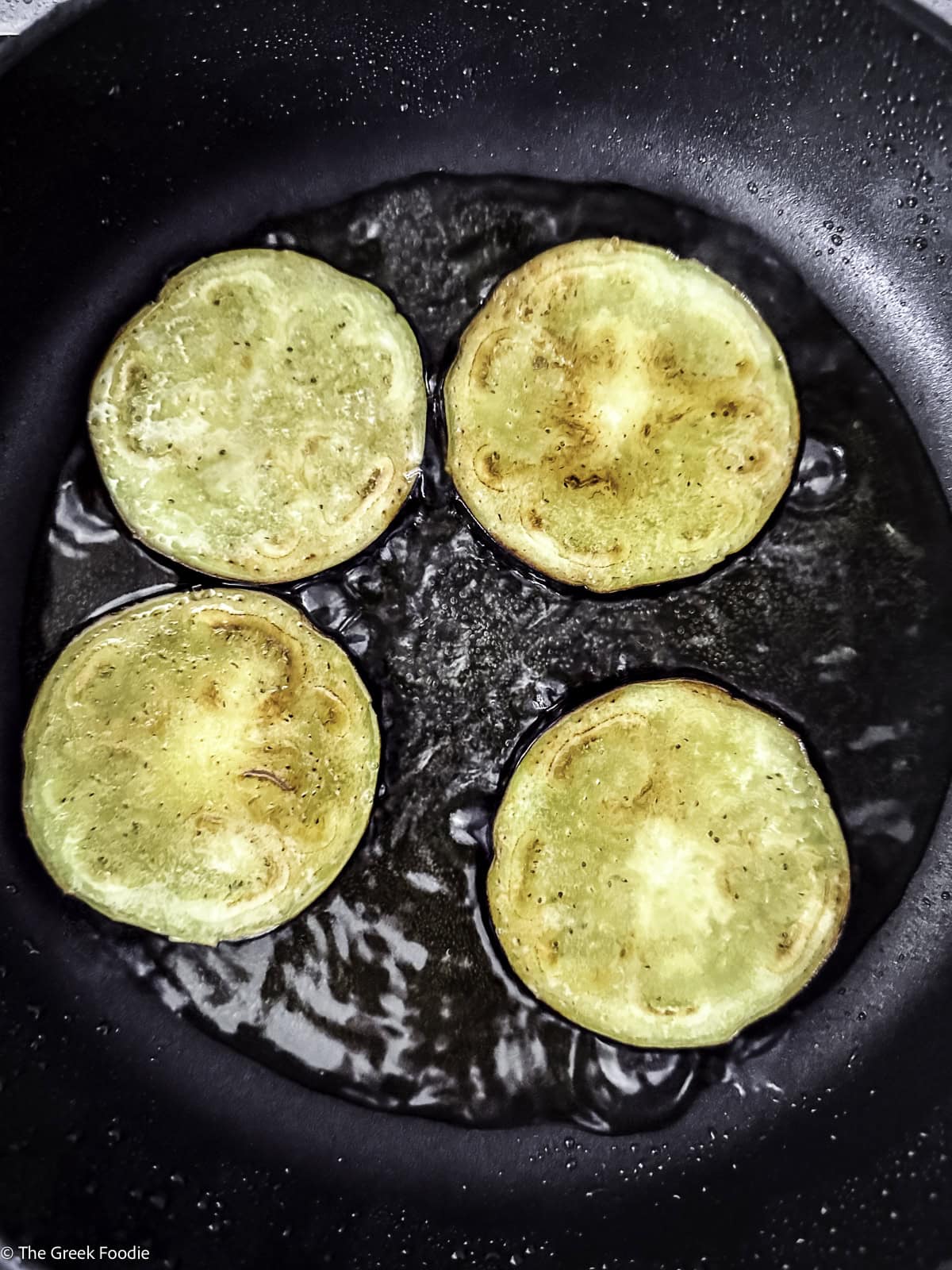
- Pat the eggplants dry with a kitchen towel.
- Fry the eggplant slices in hot olive oil until lightly golden, about 2–3 minutes per side. Transfer to a wire rack to drain.
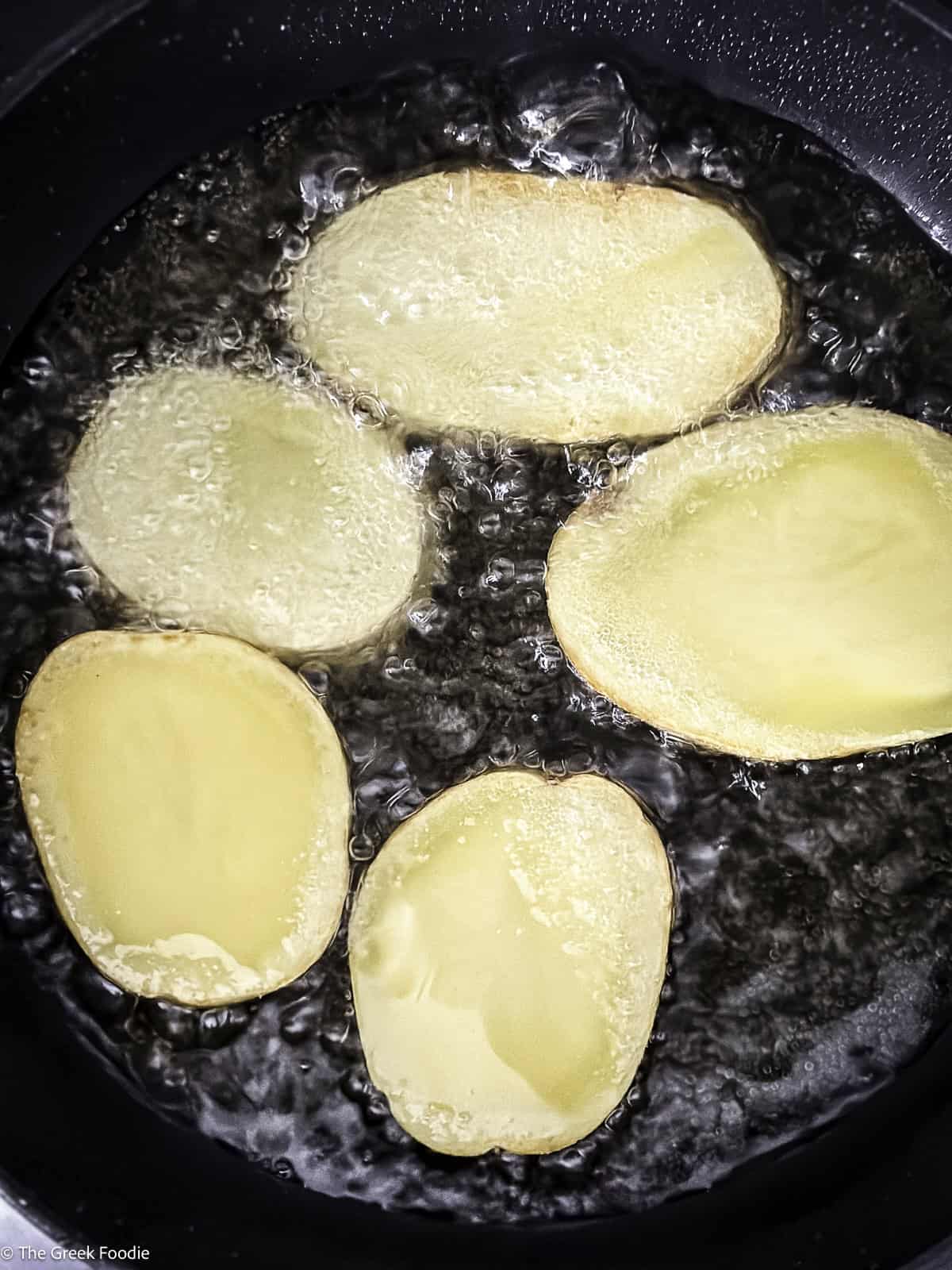
- Fry the potato slices in the same way, about 1–2 minutes per side, and transfer to a wire rack.
Start the Assembly
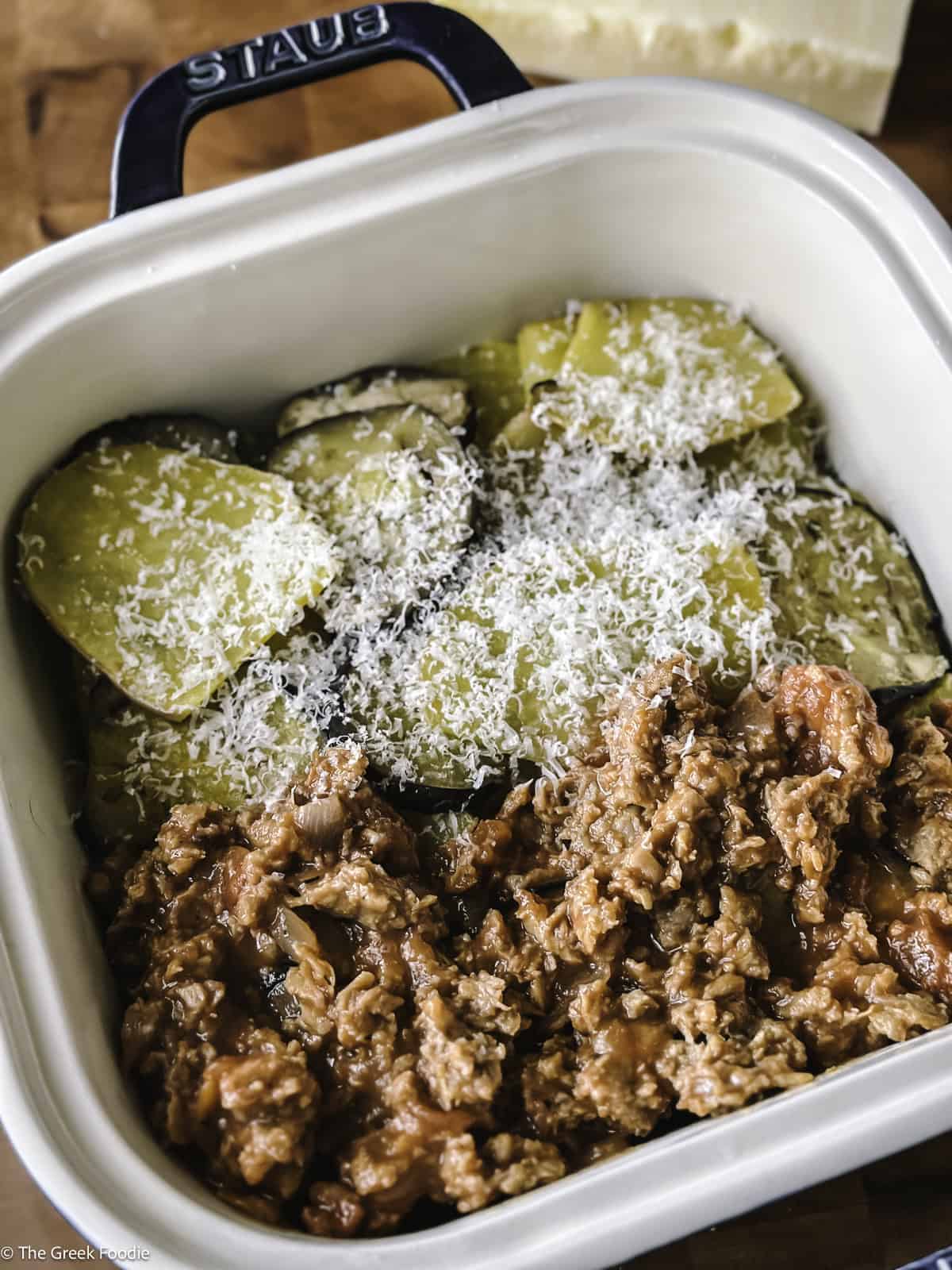
- Add a layer of potatoes to the bottom of your baking dish. Season with sea salt and freshly ground pepper.
- Add a layer of eggplants, then repeat — another layer of potatoes and another of eggplant. Sprinkle grated cheese between each layer.
- Remove the cinnamon stick and bay leaf from the sauce. Pour the sauce evenly over the layered vegetables and sprinkle with more cheese.
- Preheat the oven to 200°C (390°F).
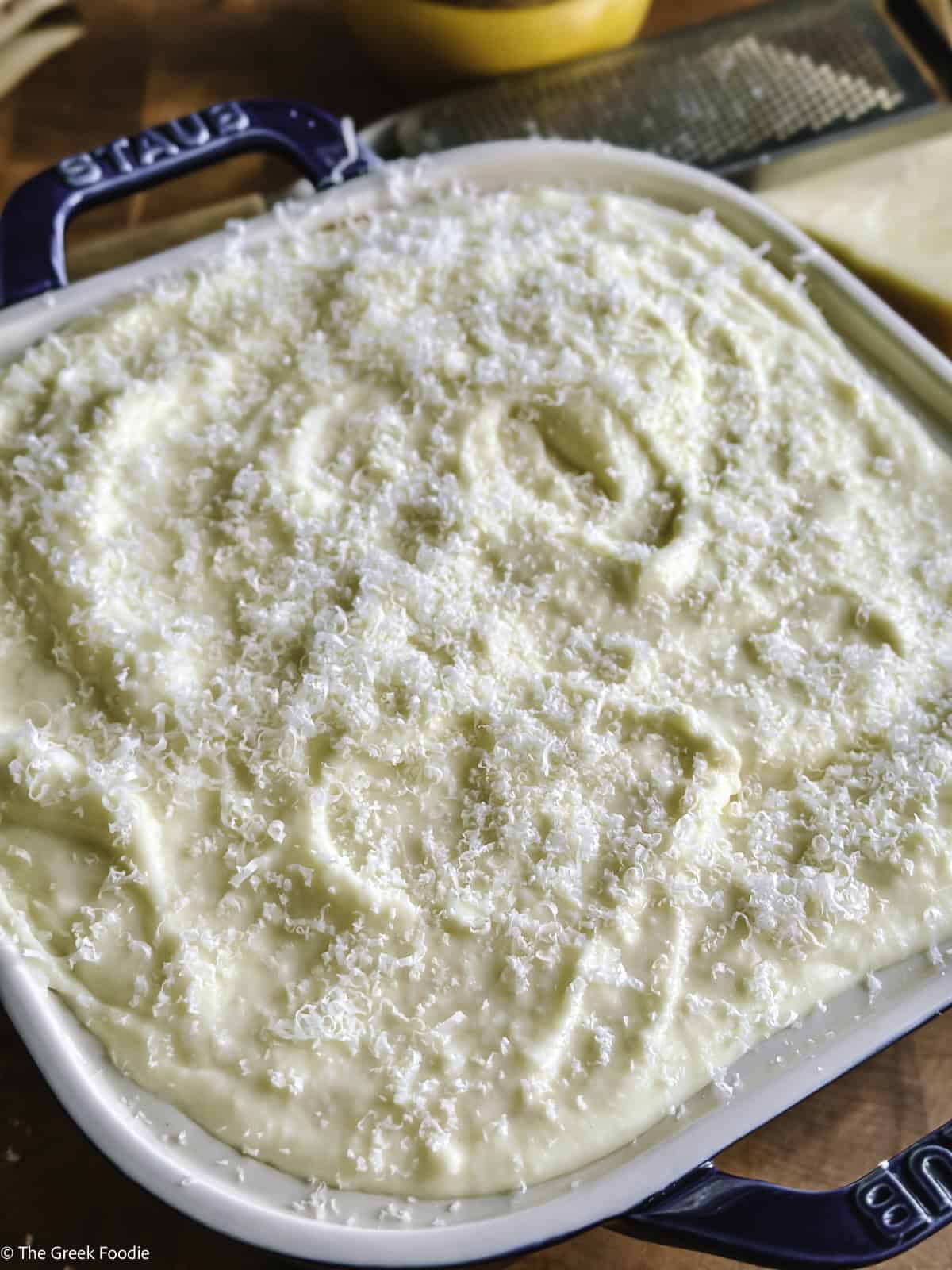
- Make the béchamel sauce. You can follow the traditional version from our classic moussaka recipe or the vegan version below.
- Pour the béchamel evenly over the top.
- Top with a final sprinkle of grated cheese.
- Bake 45–60 minutes, until the top is golden and slightly puffed.
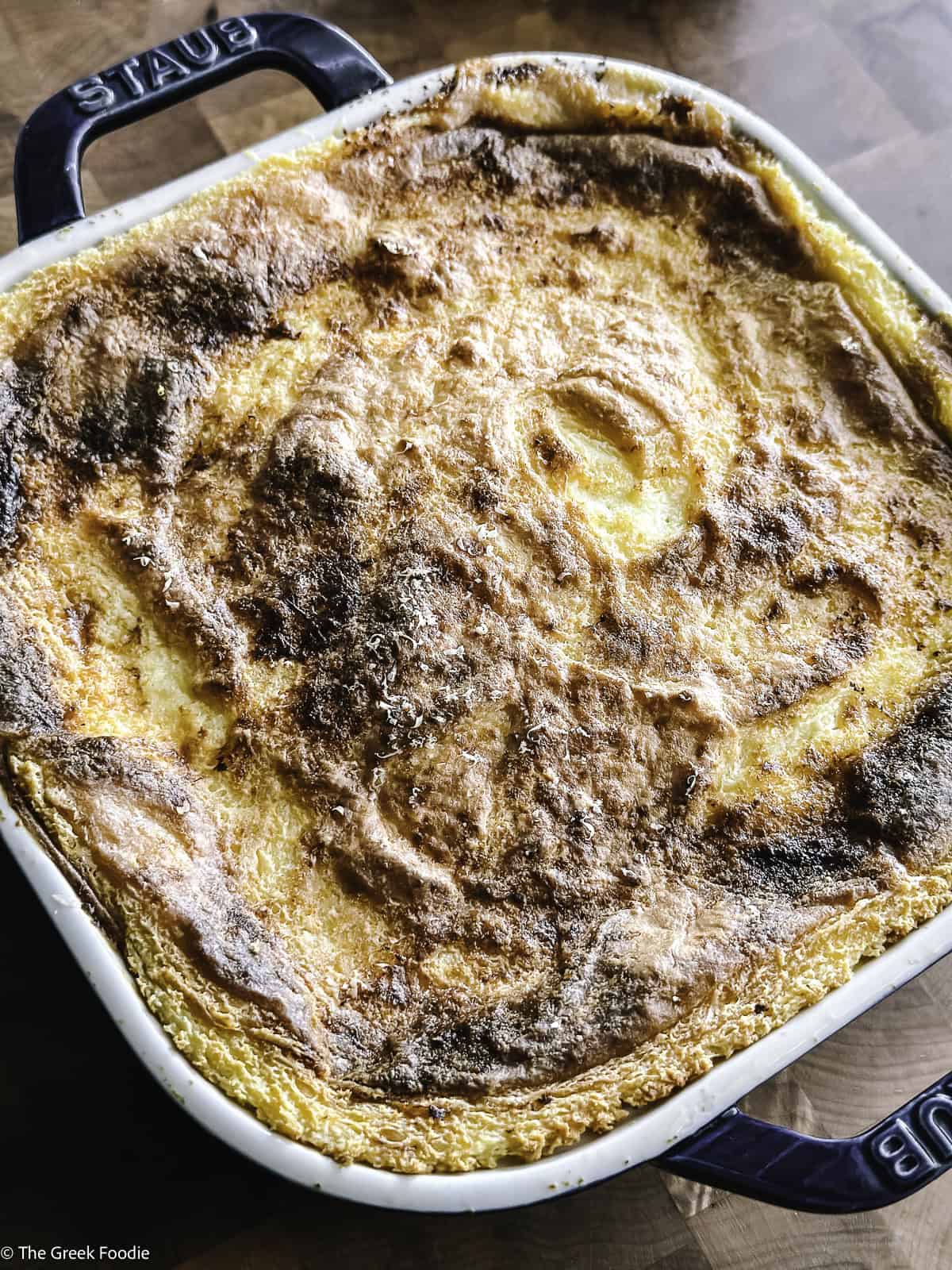
Rest 15–20 minutes before slicing so the layers set cleanly.
🌿 Vegan Béchamel Recipe
This vegan béchamel is creamy, smooth, and full of flavor — a lighter dairy-free topping that brings the same comfort and richness as the traditional sauce. It bakes beautifully golden and pairs perfectly with the plant-based layers of your moussaka.
Ingredients
- 5 cups vegetable broth
- ¾ cup potato flakes (for mashed potatoes)
- ½ cup olive oil
- ¾ cup all-purpose flour
- A pinch of ground nutmeg
- Sea salt, to taste
- Freshly ground white (or black) pepper, to taste
Method
- Pour the vegetable broth into a saucepan and bring it to a gentle simmer.
- Remove from heat and whisk in the potato flakes, stirring slowly until fully dissolved and smooth.
- In a separate saucepan, heat the olive oil over medium heat. Add the flour and stir continuously until it forms a smooth paste with a light golden hue.
- Gradually pour in the warm broth mixture while whisking to prevent lumps.
- Continue stirring until the sauce thickens and becomes silky.
- Season with nutmeg, sea salt, and freshly ground pepper.
The sauce is now ready to spread over your moussaka before baking.
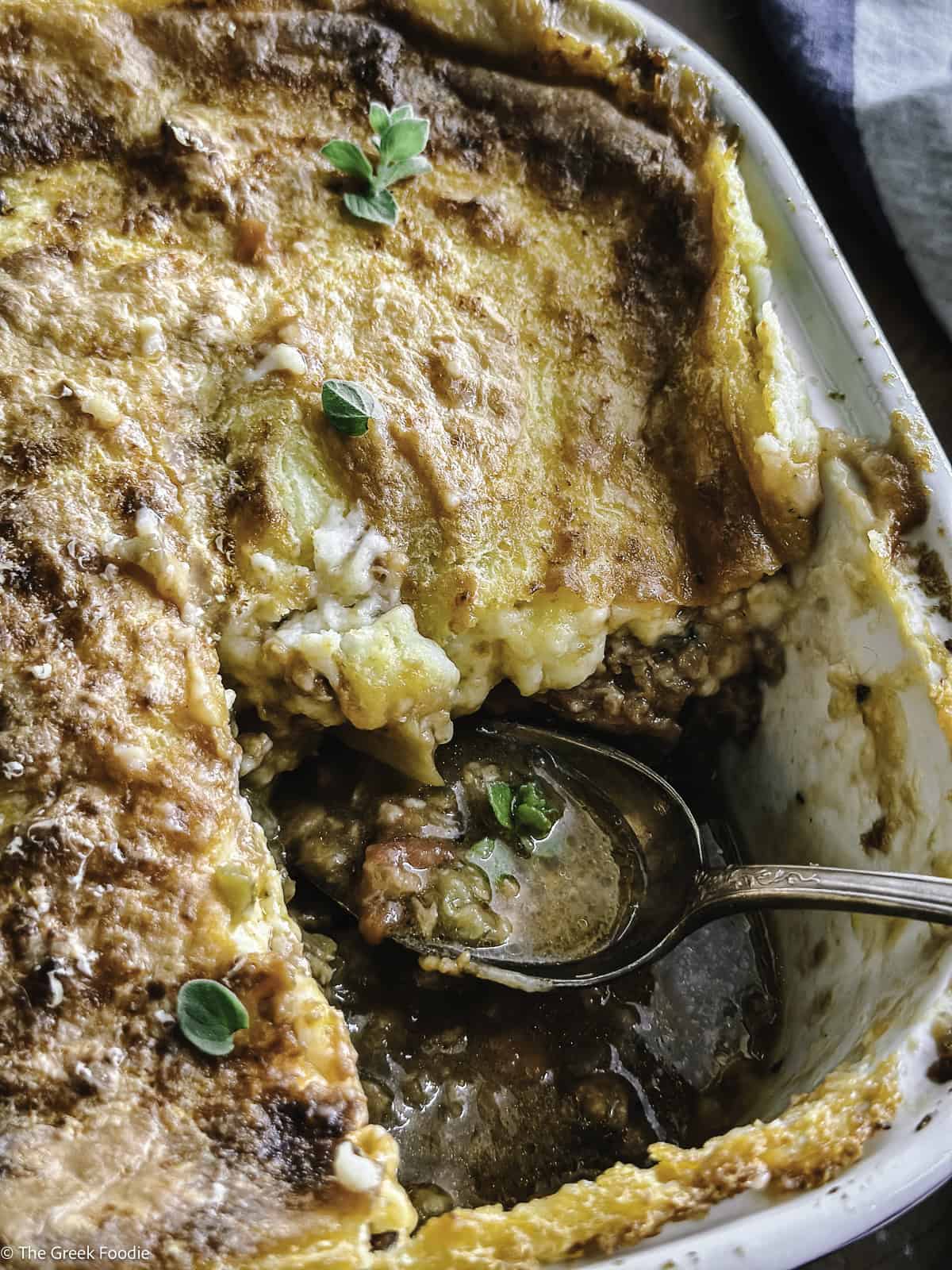
Pro Tips for Success
- Stay organized.
Have all your components — sauce, roasted vegetables, and béchamel — ready before layering. Moussaka is much easier when everything is prepped and still warm. - Don’t skip the rest time.
Let the moussaka sit for at least 20 minutes after baking. The layers will set beautifully, making it easier to slice and serve. - Use quality olive oil.
A good Greek or Mediterranean extra virgin olive oil adds authentic flavor to every layer — from the sauté to the final drizzle. - Season in layers.
A little sea salt and pepper between the vegetables and sauce keep the flavors balanced throughout the dish. - Make it ahead.
Assemble the moussaka up to a day in advance, refrigerate it covered, and bake before serving. Perfect for dinner parties or Sunday meal prep. - Choose the right pan.
A deep baking dish (about 9 × 13 inches) works best to hold all the layers comfortably and ensure even baking. - Skip the frying if you prefer.
You can prepare the vegetables in lighter ways — they’ll still taste amazing and keep that classic moussaka texture.- Air fry:
Toss potato slices with olive oil, sea salt, pepper, and a pinch of oregano. Air fry in the basket for about 15 minutes.
For eggplants, brush both sides with olive oil, season, and arrange in one layer in the air-fryer basket or rack. Cook for about 15 minutes, until lightly golden. - Roast:
Line a baking sheet with parchment paper and arrange the seasoned potatoes in a single layer. Roast for 15–20 minutes at 180°C / 360°F.
Brush eggplant slices with olive oil, season, and roast on a parchment-lined sheet at the same temperature for about 15 minutes.
- Air fry:
- Make the most of leftovers.
Extra béchamel and sauce are perfect for quick dishes — layer them into individual eggplant lasagnas, a simple vegan bolognese for two, or mix into eggplant pasta for an easy, comforting pastitsio-style bake.
Storage and reheating
- Refrigerate: Cool completely, then refrigerate airtight 3–4 days.
- Freeze: Whole or sliced portions freeze well for 2–3 months. Cool, wrap tightly, and label. Thaw in the fridge overnight before reheating.
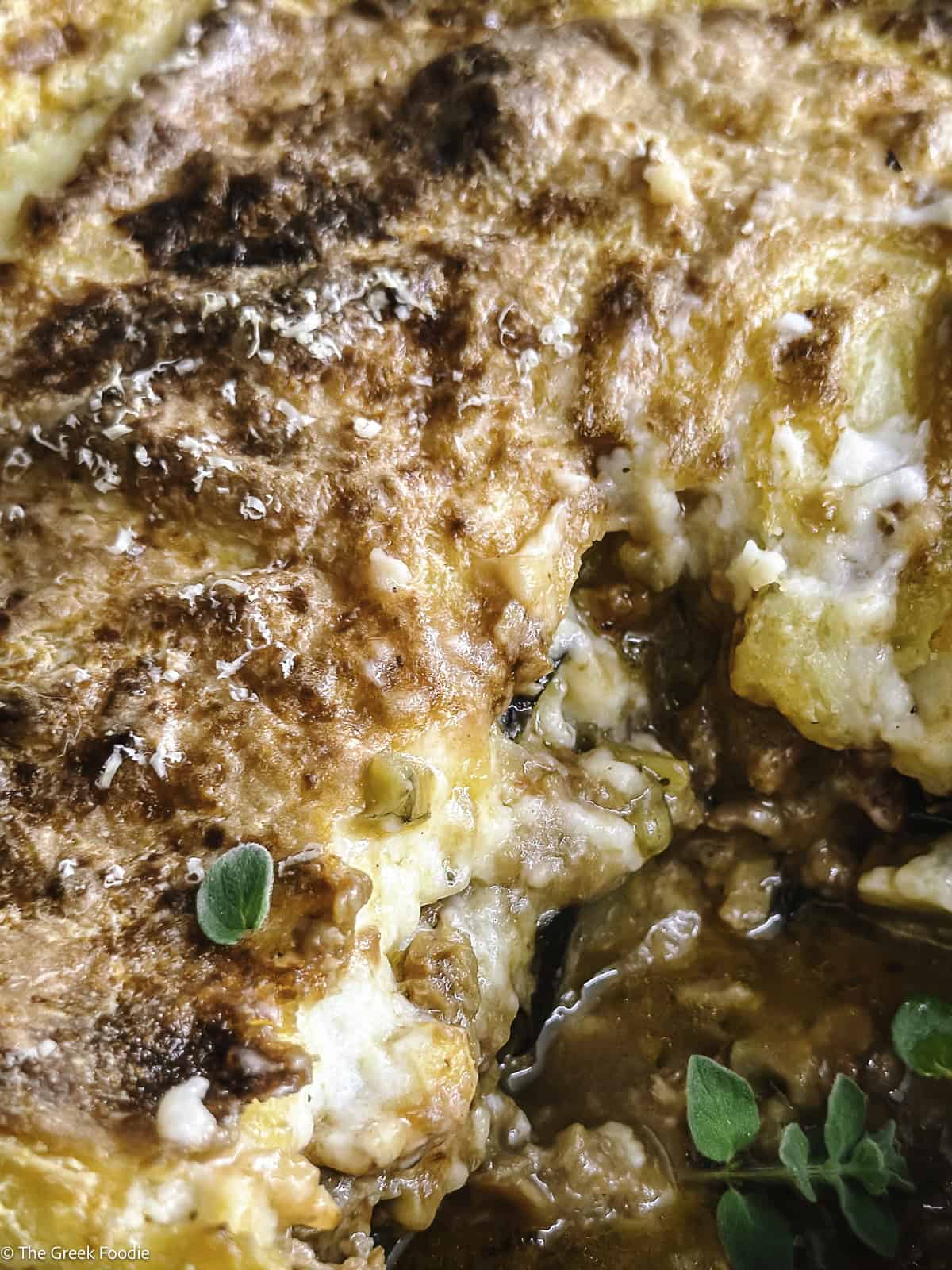
Side dishes for vegetarian moussaka
Pair this rich, cozy bake with bright, fresh sides:
- Feta & Olives: Marinated olives with feta, lemon, and herbs.
- Greek Horiatiki Salad: Tomatoes, cucumbers, onion, feta, and olives in extra-virgin olive oil.
- Tzatziki: Cooling yogurt, cucumber, garlic, and dill.
- Pita Bread: Warm and soft — perfect for scooping.
- Cauliflower and Broccoli Salad: Crunchy veg with a light vinaigrette.
More Greek traditional recipes

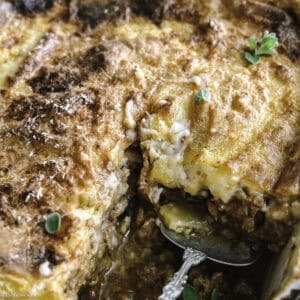
Vegetarian moussaka
Equipment
- medium sauce pan
- Rimmed baking sheet
- 8“ square baking tin
- frying pan
Ingredients
- 1 lb plant-based ground meat like Beyond beef
- ½ cup extra virgin olive oil total
- 1 red onion medium size, diced
- 3 cloves garlic minced
- 1 teaspoon ground nutmeg
- 1 teaspoon ground cumin
- 1 cinnamon stick
- 3 cloves
- 1 bay leaf
- 1 tablespoon tomato paste
- ½ cup red wine
- 1 cup crushed tomatoes
- 1 teaspoon sugar
- 3 yukon gold potatoes scrubbed and sliced
- 1 large eggplant sliced
- 1 cup grated parmesan cheese like parmigiano reggiano
for the béchamel
- 2 cups bechamel sauce Please. see recipe notes for a vegan bechamel recipe
you will also need
- freshly ground pepper
- dried oregano
- sea salt
- olive oil for frying try bertolli light olive oil
- chili flakes for serving optional
Instructions
- Heat two tablespoons of olive oil in a deep saucepan and brown the ground plant-based meat over high heat, stirring and breaking it with a spoon.
- After the meat browns, add the diced onion, garlic, sea salt and pepper, cinnamon sticks, bay leaf, ground nutmeg, cumin and two or three cloves.
- Saute the onion and garlic for a few minutes, then add the tomato paste. Stir and cook for two to three minutes, then pour the wine. Allow the alcohol to evaporate.
- Add the tomatoes, a teaspoon of sugar, and stir. Simmer the sauce for 20 minutes on low heat.
Prepare the eggplant and potatoes.
- Cut the eggplants into slices about 1 cm / ⅓ inches thick. Sprinkle slices with sea salt, and place them on a colander to drain their liquids for 15 minutes.
- Cut the potatoes into 6 mm / ¼ inch thick slices. Place slices into a bowl of water while you slice. When all is done, drain and pat dry.
- Add a frying pan over medium-high heat. Pour in about two or three tablespoons of olive oil
- Pat the eggplants dry.
- Fry eggplant slices in hot olive oil until they take on color, about 2-3 minutes.Transfer to a wire rack and set aside.
- Fry the potato slices in the hot olive oil until they take on color, about 1-2 minutes.Transfer to a wire rack and set aside.
Start the assembly
- Add a layer of potatoes to the bottom of your baking pan and season with sea salt and freshly ground pepper.
- Layer the eggplants. Add another layer of potatoes, and right after a layer of eggplant. After each layer, add grated cheese.
- Remove the cinnamon stick and bay leaf from the meat sauce and pour it evenly over the vegetables. Sprinkle a generous amount of grated cheese.
- Preheat the oven to 200°C / 390°F
Make the bechamel sauce
Finish assembling and bake
- Pour the béchamel over the meat in an even layer.
- Sprinkle grated cheese on top. Bake for 45 minutes to one hour or until the top is golden brown.
- Let moussaka sit for 15 minutes before serving.
Notes
Tips and tricks
-
- Bechamel sauce—Make the bechamel sauce according to our recipe for traditional moussaka.
- Make it vegan moussaka. The plant-based meat works great, just like ground beef, and the traditional moussaka seasonings help enrich the flavor. This recipe transforms into a vegan moussaka, with instructions for vegan béchamel below. Additionally, use vegan cheese and make a Bolognese with tofu or lentils.
-
- Tomatoes—If you can afford it, choose canned authentic San Marzano tomatoes and pulse them in the food processor.
-
- Dry red wine—Dry white wine will also work. If you prefer not to use alcohol, omit from recipe.
Vegan bechamel recipe
Ingredients
-
- 5 cups vegetable broth
- 3/4 cup potato flakes for mashed potatoes
- 1/2 cup olive oil
- 3/4 cup all-purpose flour
- 1/2 teaspoon ground nutmeg
- sea salt
- freshly ground white pepper
Method
-
- Pour the vegetable broth into a saucepan and bring it to a simmer
- Remove from the heat and add the potato flakes, stirring slowly until they dissolve well.
- Add the olive oil and flour to another saucepan and stir over medium heat until the mixture turns golden brown.
- Slowly pour in the broth mixture and stir.
- Simmer until the sauce thickens.
- Add the nutmeg, sea salt, and freshly ground pepper. The sauce is ready for the final step of moussaka.
Tips and tricks
-
You don’t like anything fried? No problem! You have two options.
-
- Air fry: Toss the potato slices with olive oil, sea salt, pepper, and a generous pinch of oregano, and air fry in the basket for 15 minutes. For the eggplants, brush olive oil on each side of the slices, season, and line them up in one layer on the air fryer basket or rack. Air fry for 15 minutes.
- Roast: Line a baking sheet with parchment paper and add an even layer of seasoned and oiled potatoes. Roast for 15-20 minutes at 180°C / 360°F. For the eggplants, brush olive oil on each side of the eggplant slices, line them up on a parchment-lined baking sheet and roast at the same temperature for 15 minutes.
-
Nutrition
